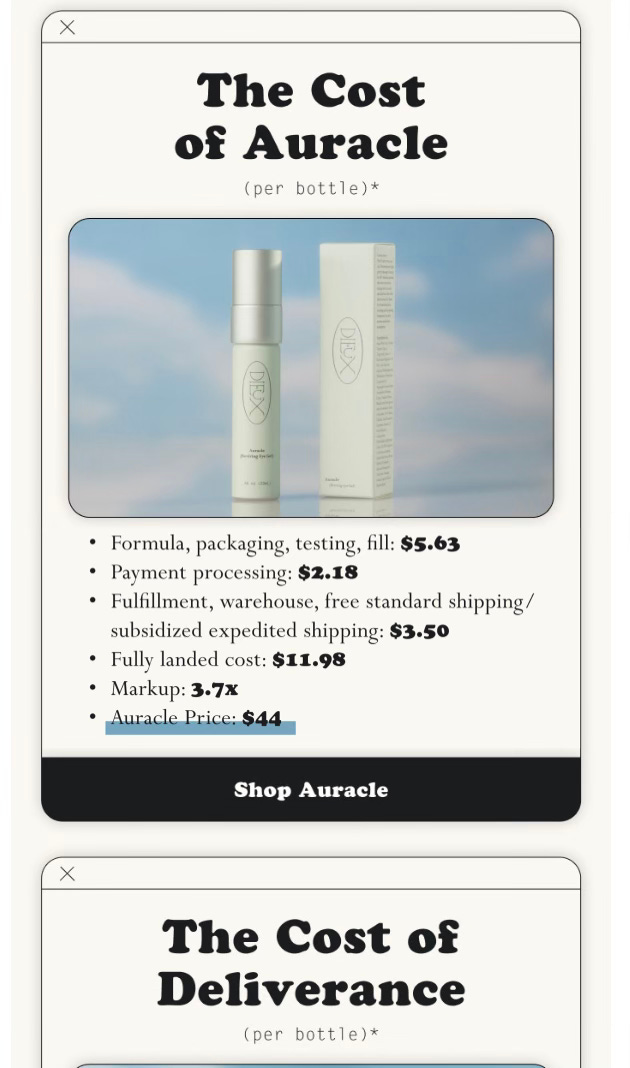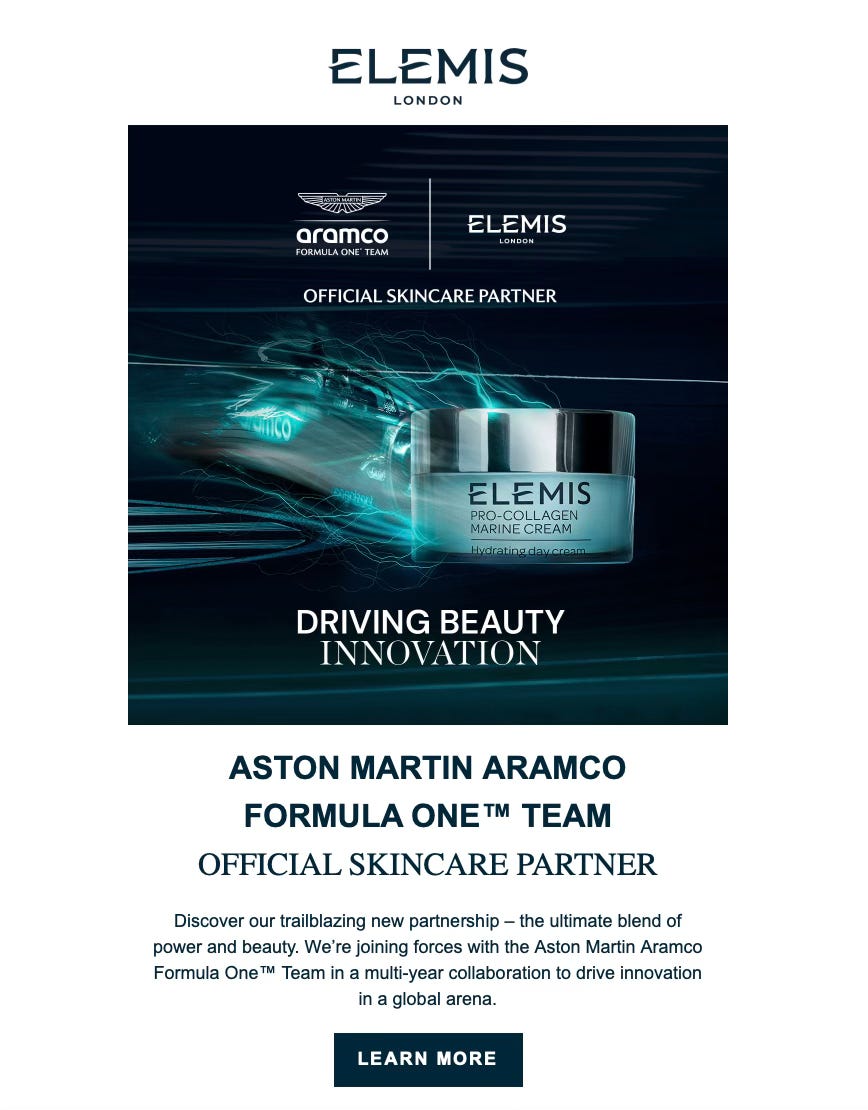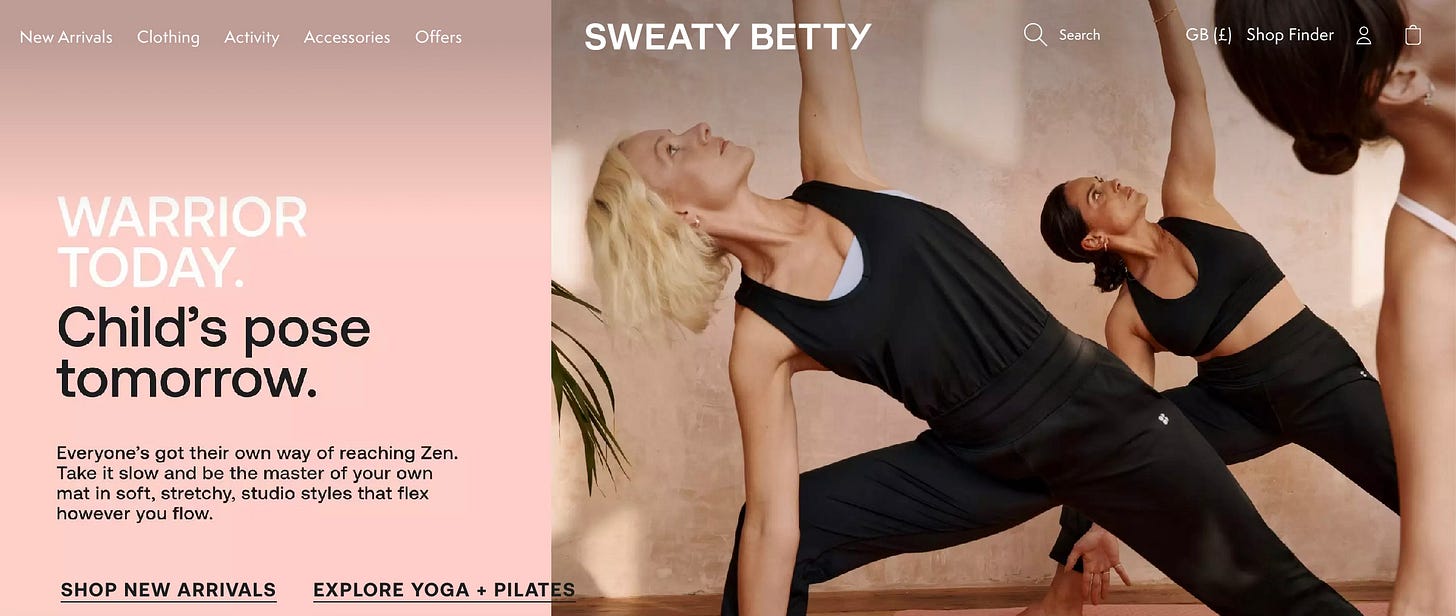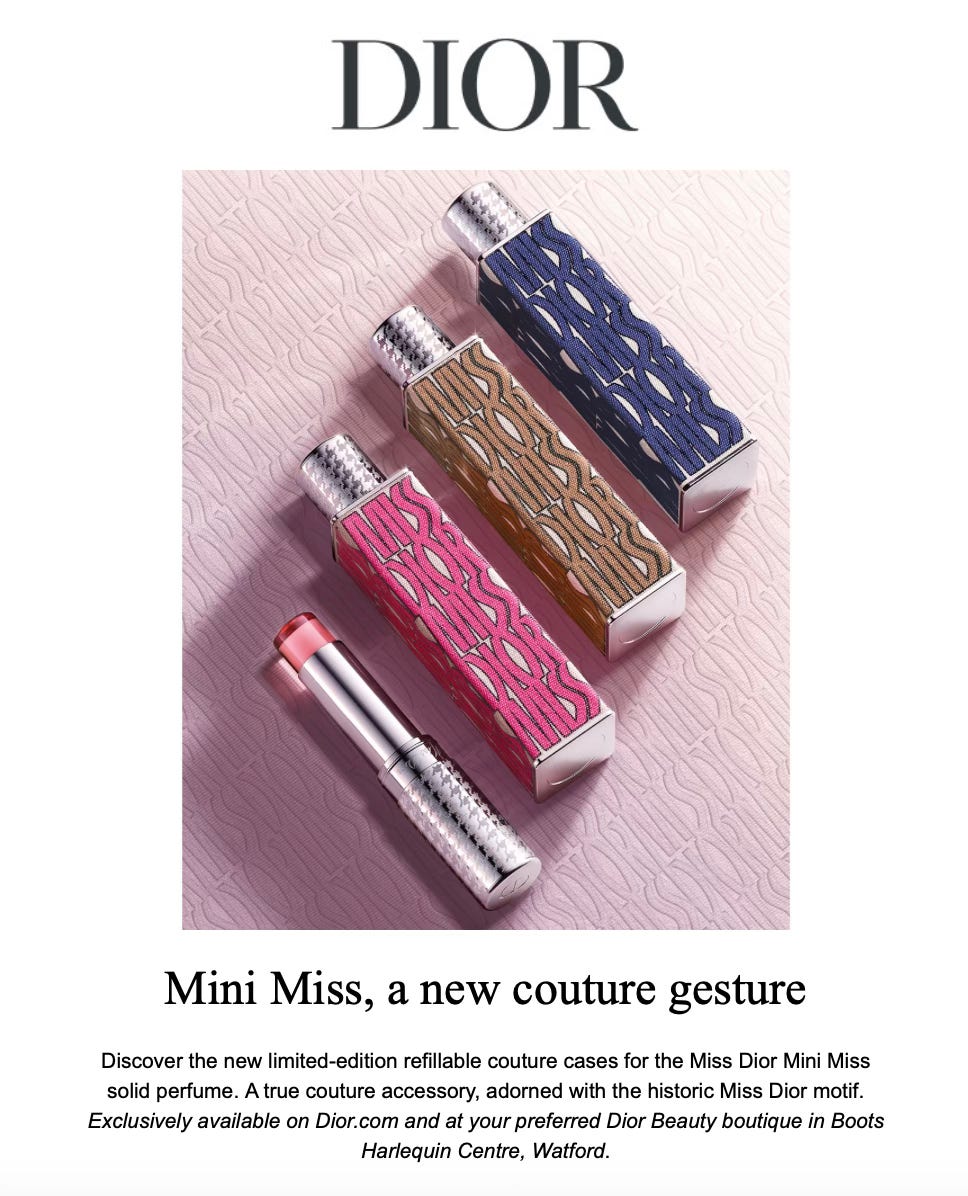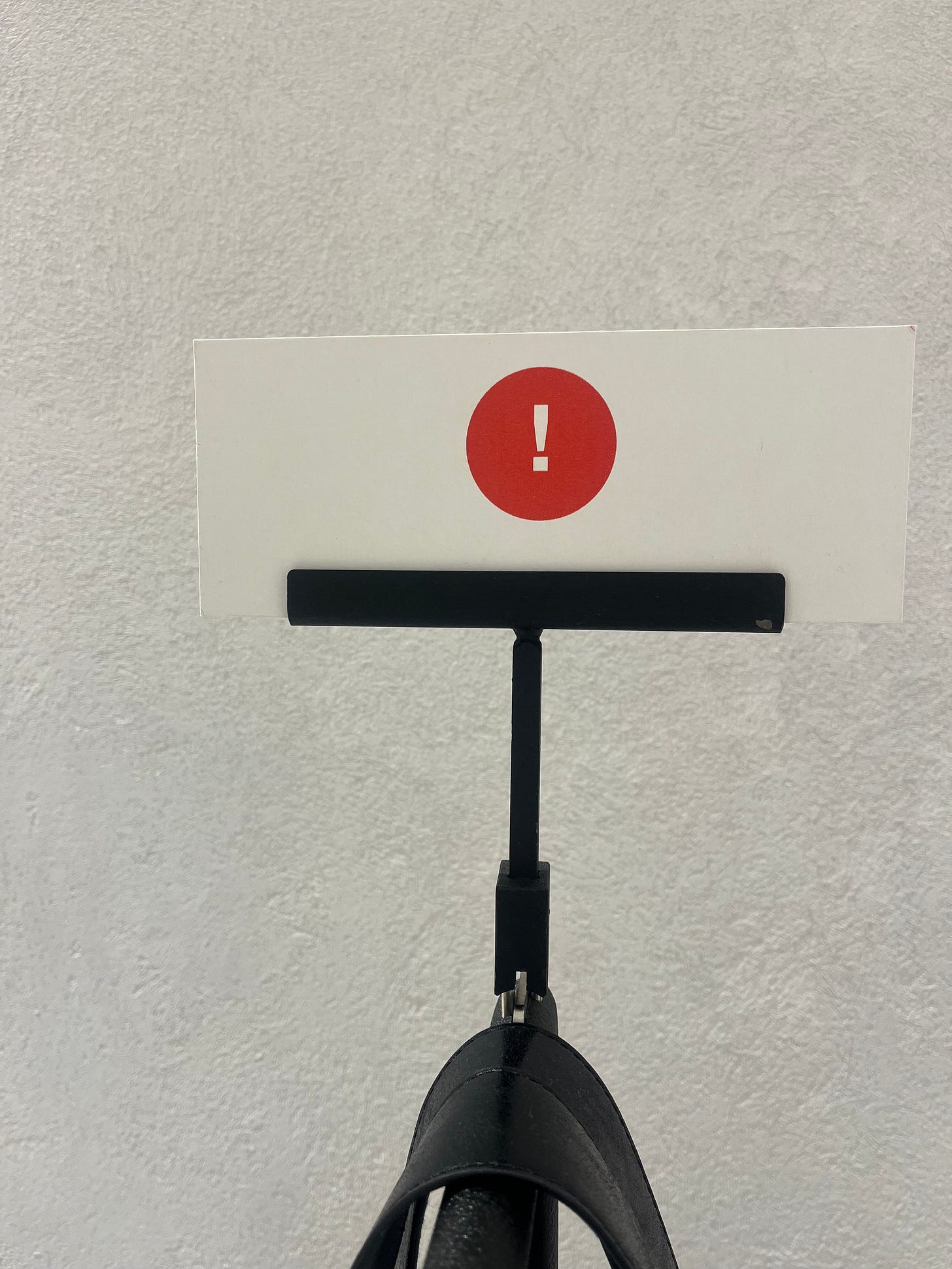Thursday Round Up: Getting creative with returns, The Ordinary and Dieux are advocating for transparency, and Elemis has entered the fast lane with Aston Martin Aramco.
#63: This is In The Loop’s Thursday round-up where you’ll find retail, fashion & beauty news and trends, through the lens of a retail strategist who loves to shop, share & dive in to all the latest.

In case you missed it, in this week’s Retail Lab I put Sézane’s strategy in the spotlight, taking a deep dive in to how their minimal product drops and limited order runs lead to increased wait lists, growing sales, and a customer base that’s excited to spend more on products that will never go out of style. Sézane makes products with purpose that last beyond a season, so customers spend more and come back for more; in other words, longevity sells.
It’s a smart strategy. Mass production isn’t always the best move even for bestsellers because it leads to excess inventory (which customers can spot) and costs money to store and markdown, eroding margin. I hope Sézane maintains this ethos as it grows. If you want to read more, you can find that edition of Retail Lab here.
This piece on Sézane came about because since the start of 2025, I’ve been thinking a lot about smart retail strategy and how retailers can make better decisions that benefit the sector and their bottom line, which is why in this week’s round up, you’ll find:
Reflections of a Retail Strategist on getting creative with returns
So Many Thoughts on how The Ordinary is using the launch of its new GF 15% Solution to build trust through transparency
I got mail - a round up of the best of what hit my inbox and social media feed this week
Bookmarked articles you need on your radar
Updates on my retail strategy consulting business, Retail Collaborative
Changes to my Substack schedule. (Spoiler alert: I’m now switching these weekly round ups to a monthly schedule)
💫 Reflections of a Retail Strategist
On how returns can be better managed.
We hear a lot about returns every January.
Offering lengthy return windows for sales in November to the end of January are the norm now, but from a stock management perspective, this can quickly turn in to a nightmare.
An influx of out of season returns and huge refunds can and often do offset seasonal sales lifts, leaving retailers wondering how to clear the stock while managing incoming deliveries without taking a huge margin hit. It’s a tricky balance, but an expected challenge every January as customers take advantage of discounts and then decide whether they actually want what they’re buying.
From a retailer’s POV, it can feel frustrating, which is why we’ve seen them take drastic action like:
Charging for returns. This is increasingly becoming the norm, but isn’t always popular with customers
Restricting serial returners’ orders. ASOS have tried this and believe it can prevent social media haul shopping, but it has undoubtedly come at the huge cost of customer satisfaction
But there’s also another more creative option: using returns as a resale opportunity.
This article on glossy.co highlights Hobo Bags and M.M.LaFleur as two retailers embracing returns as an opportunity to add another strand to their businesses.
Lightly damaged items are refurbished and listed for sale at a discount;
Customers returning products that don’t fit the standard returns policy are directed to list them on the resale website;
Old season stock is discounted and given a new lease of life in store and online so customers can discover past season favourites.
The advantages are undeniable and include:
Capturing sales that otherwise would have been lost
Less inventory wastage and write offs
Increased sustainability
Strengthened customer relationships
Increased discoverability factor
A discount entry point for those who are priced out of full price
Using resale data as an invaluable resource to assess pricing architecture and future products
Fewer storage costs
Control over how branded products are marketed for resale, preserving brand value
Resale is becoming increasingly popular so using returns in this way is also a fantastic way to trial this new way of shopping without a huge investment.
📌 Takeaway: It’s frugal and in a tough market, these smart strategic moves can make all the difference.
💡 So Many Thoughts
On how The Ordinary is using the launch of its new GF 15% Solution to build trust through transparency.
First things first, if you haven't seen this new website from The Ordinary, take a look; it’s brilliant.
As they launch their new GF 15% Serum, The Ordinary has taken the extraordinary move of publishing a website dedicated to debunking beauty industry myths by breaking down scientific papers in to digestible information for all beauty consumers. It’s the information we’ve all been searching for to inform our beauty purchases, and best of all, it’s free.
It’s a clever move for many reasons:
It gives customers access to what was previously seen as privileged information for scientists;
By making it available they’re practising what they preach: transparency;
It engineers intimacy and builds trust;
It forces other brands to be clear in their messaging and justify their pricing.
With the success of Beauty Pie, it’s clear that customers are wising up to the mark-ups in luxury products, and this step by The Ordinary makes their products stand out for representing efficacy and value for money.
Also, as customers become more conscious in their shopping choices, they are demanding details and honesty.
On a similar note, if you’re not signed up to the Dieux mailing list, you’re missing out. This email titled “The Real Cost of our Products” dropped in to my inbox recently and it breaks down the cost and mark up of Dieux’s bestselling products to justify their pricing. It’s simple, but impactful and I love the honesty.
I also enjoyed reading their email which broke down how peptides work.
These communications make me feel valued and inspired to go and buy more of their products.
Let’s hope transparency is more than just a trend.
💌 I got mail
A round up of the best of what hit my inbox and my social media feed this week
Elemis is teaming with the Aston Martin Aramco Formula 1 team to become its first b corp partner. The sport is becoming increasingly popular with women (40% of the audience is now female) and this represents an opportunity for brands and teams to reach new audiences. This is a particularly neat tie up because the visuals are seamless but as we look beyond the surface, it’s clear that the two brands have much in common. I can’t wait to see the innovative product launches and spa experiences that are already in the pipeline. Read more about it here.
The new Sweaty Betty campaign is the perfect reflection of what exercise looks like for most people, and it’s refreshing to see rest days and recovery portrayed as part of the strengthening process. Real women in real scenarios in real life is a far cry from the polished workout adverts we’ve become used to.
I’m a sucker for packaging and it doesn’t get cuter than these Mini Miss solos perfume refill cases from Dior
Mint Velvet launched MV World, their style and inspiration hub that’s akin to a magazine, and it’s a brilliant way to connect with the customer, teach them more about the brand, its ethos and its products and go beyond the products to provide a more personal experience online. It’s the perfect example of creating what your customers are asking for.
It’s been around for a while but I noticed the Zara “pay attention” sign again in store this week, highlighting special priced items. It’s an example of how subtle but effective signage can draw a customer’s eye and attention in a large space.
🔖 Bookmarked
News you need on your radar
Canada Goose fascinates me. It’s seemingly everywhere, which is incredible when we consider its luxury pricing architecture. But at the same time, practical clothing that actually works in cold weather climates is an essential, and few other brands can claim to have the same product functionality as Canada Goose. This article in Business Insider is a great read, and the 20 min video in this one is worth a watch if you want to know more about why it’s so
Net Sustain from Net-à-Porter is not new, but after starting with just 26 brands under its umbrella, there are now over 200 listed on the sustainability section of the luxury e-tailer’s offering. This article is a good read if you want to know more about what’s driving this growth and what it means for the wider sustainable luxury sector.
⭐️ Retail Collaborative
Updates on what you can expect.
This is the perfect time to review your strategy and get your business in shape for 2025. I offer the option of a free call so don’t hesitate to get in touch to see how I can help.
I’m also launching new services soon, so sign up to In The Loop to make sure you don’t miss a thing.
💫 In The Loop
My Substack is changing
I’m switching this weekly round up to a monthly one, so you can expect your next edition on 27 February and it will cover all the best news, trends and updates from February, plus all my musings (expect a long read);
My Retail Lab deep-dive will continue to be sent out every Tuesday. In next week’s edition I’ll be talking about the power of basics and the rise of retailers selling high-quality essentials.
You can catch more of my musings and findings over on Linkedin and Instagram in between my Substacks.
I’d love to hear what you think of this week’s edition, or about any suggestions you have for future topics I should cover, so get in touch!
Until Tuesday,
Hina



